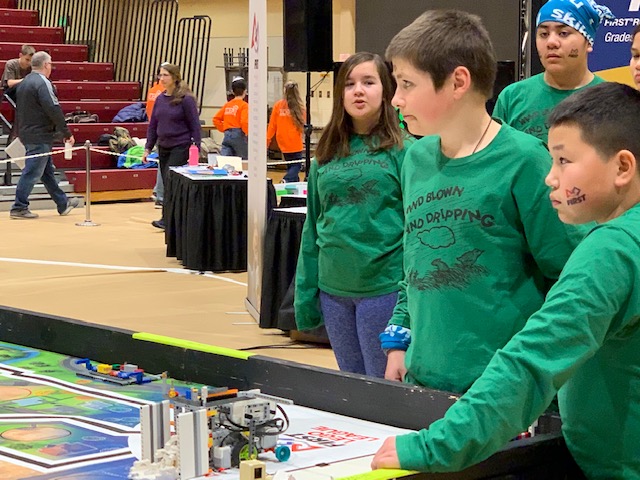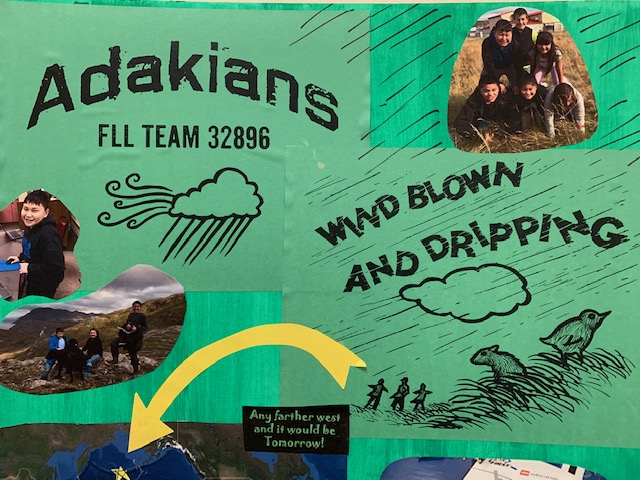On Saturday, January 18, 2020, 51 teams from all over Alaska converged on Anchorage at Dimond High School for the 2019–2020 FIRST LEGO League in Alaska Invitational Championship (FIRST, For Inspiration and Recognition of Science and Technology). This international program is a robotics competition for 9 to 14-year-olds, where teams research and develop a solution to a real-world engineering challenge, present it for judging, and build LEGO-based robots designed to complete tasks in competition.

Among those in attendance was Adak School, a team that caught one of two available flights per week to fly in from one of the farthest inhabited islands on the Aleutian Chain. Though the Adakians didn’t place at the competition, the incredible experience of competing in-person and interacting with other students, judges, and onlookers was one they will not soon forget—and they thank GCI, in part, for that opportunity.
GCI invests hundreds of thousands of dollars per year in education organizations in Alaska.
GCI’s Education Program was developed in part to help rural communities gain access to the same caliber of programs, tools, and resources that are made readily available to urban schools. GCI invests hundreds of thousands of dollars per year in education organizations in Alaska. That support goes well beyond financial contributions and includes volunteerism, board representation, and the provision of essential connectivity and technology that allows students to participate in and support competitions and programs virtually, enjoy distance learning opportunities, and more. In the case of FLL, GCI provides connectivity and equipment to teams in rural Alaska. Through the use of video conferencing technology, GCI can connect up to 16 teams in village schools to the FLL challenge site on tournament day. GCI assists with video conferencing equipment that allows students to run their robots on the playing surface in their school and to be evaluated by the tournament judges. Adak was able to compete remotely and qualified for the state championships.
FLL’s mission is to inspire young people to be science and technology leaders, by engaging them in exciting mentor-based programs that build science, engineering, and technology skills that inspire innovation, and that foster well-rounded life capabilities including self-confidence, communication, and leadership. As the Education Program Manager at GCI, this is the type of program that thrills me to be involved with. I attended the competition and caught up with Adak’s coach, Lisa Spitler, to hear her take on whether FLL lives up to its mission and to better understand the value of the program in rural villages. She had nothing but positive things to say:
How did FLL make its way out to Adak?
Mike Reed was a pilot for Alaska Air who flew to Adak until he retired. Year after year, he encouraged the school to consider starting a FIRST program, and eventually they reached out to me and away we went. We also greatly benefited from a visit from another longtime FLL coach, Elaine Todd, who volunteered to come to our school and hold a robotics class. Her tips and tricks were a huge help to us, and her willingness to come so far to help was really wonderful. This is Adak’s third season participating in FLL, and I’ve been their coach from the beginning.

FLL is a very accessible program, thanks in part to partners like GCI and also for its universally adaptable format. Even so, not all Alaska schools have teams to represent them. Why would you advocate for schools to participate in FLL?
My personal opinion is that FLL is a relatively inexpensive and exceedingly fun way to provide students with more STEM enrichment and after-school activity. In Adak, it’s the only after-school program available to students. FLL is also very easily supervised and supported. The team’s coach doesn’t need to have a background in engineering or programming, or even in any scientific or technical field, because the kids and coach learn together as they go. This makes it a really unusual STEM program—one that a school or community can implement without having anyone on hand with specialized knowledge to run it.
“FLL is a relatively inexpensive and exceedingly fun way to provide students with more STEM enrichment,”
Lisa Spitler, Adakian FLL Coach
A third reason to participate in FLL is that the assigned project can often be designed to solve a problem in the local community, and it is very empowering for students to realize they can use their efforts to make things better, in real life and right now. The team is encouraged to share their project and solution with their community, and in our case, this has resulted in lots of offers of help and support, and collaborations that have ensured the success of the team’s vision. All of these reasons make FLL especially valuable in rural Alaska, where it might be the only STEM enrichment available to students, and where opportunities to engage with the community exist but are not always recognized.
You mentioned FLL being especially valuable in rural Alaska. Can you elaborate more about the significance of offering this program in rural communities?
As is the case for many small schools, we don’t have enough students to form sports teams, and traveling to participate in any kind of competition is exorbitantly expensive.
“Having a STEM program that is affordable and feasible for rural schools to implement without having to travel is a great thing,”
Lisa Spitler, Adakian FLL Coach
For example, after three seasons qualifying for the FLL State Invitational Championship, this year will be the first time the Adakians can attend in person; with only two flights a week, one of them on tournament day, it requires the team to spend an entire week in town (and their volunteer coach to take a week off work). Having a STEM program that is affordable and feasible for rural schools to implement without having to travel is a great thing in and of itself, but having the virtual tournaments to look forward to, both as motivation to work hard and simply for the fun of it, is really invaluable. Our team loves connecting with the other teams during the virtual tournaments, cheering them on, exchanging questions and greetings, and feeling like part of a bigger whole, even though we’re a thousand miles away.
In what ways do you see students grow throughout the process of preparing for competition?
Having the competition to look forward to and prepare for really motivates the team to work hard. Because the kids are meant to do the work and manage their time and make all the decisions, things often slide into chaos. With this being the second or third season for all of our team members, they’ve realized that as the tournament date starts creeping closer, they need to be more productive. Instead of the coach reminding them how much they still have to do, this year they’ve been the ones asking to meet more often, wanting to work on more programs, wanting to practice their presentations, reminding each other to focus and be productive. They were extremely motivated to do well in their qualifying tournament this year, since we had raised the money to go to Anchorage for the Invitational Championship—they really wanted to be invited!
How can students apply what they learn in competition, to their life?
In a small school like ours, there are very few opportunities to practice public speaking, so the part of competition that requires students to deliver a presentation of their research project is a great way to exercise that skill. They are also learning the value of time management. This has been our team’s biggest challenge, but they’ve seen firsthand that what they achieve is a direct result of how much effort they expend, and their self-motivation and focus have increased noticeably because of it. Another great lesson is in overcoming disappointment. It is easy for kids to get really frustrated when things go wrong with the robot, and learning how to recognize that what seems at first like failure is actually just part of an iterative process teaches them patience and perseverance, as well as critical thinking skills as they analyze the problem and figure out how to fix it. All of these are valuable skills, no matter what they end up doing in life.
What is something unexpected that has evolved from participation in FLL?
FLL has given the team a way to form connections with visitors to Adak. One example is the Navy divers that came out to Adak to set up and clear simulated underwater mines in preparation for a Marine training exercise—the Adakians were able to show the divers their robot and mission field, and the divers described the autonomous underwater drone they use to search for mines. It was really cool for the kids to hear about an identical process being used in the real world, and to have the validation of the divers’ interest and enthusiasm in their FLL efforts. I think the kids really take pride in their status as FLL team members. The younger students at school are always asking me how many years it will be until they can join the team!
GCI is proud to be a contributing factor in students’ ability to participate in such developmentally impactful programs. This year, the competition was so close that the judges had to go into deliberation before announcing the winner. Congratulations to Opportunity Bots, the 2019–2020 FIRST LEGO League in Alaska Champions, and first runner-up, Philosophers!